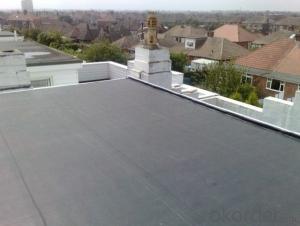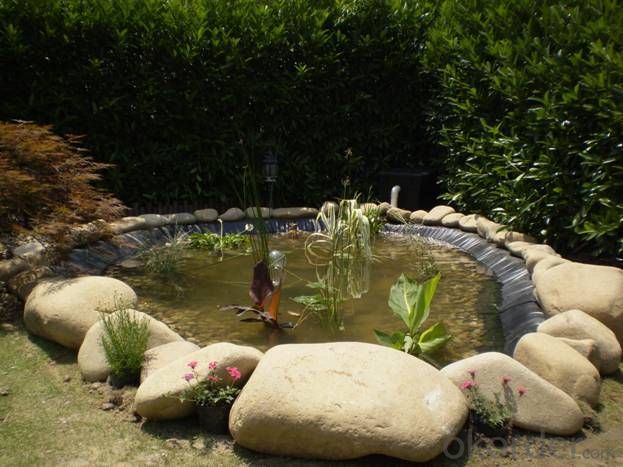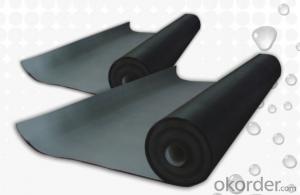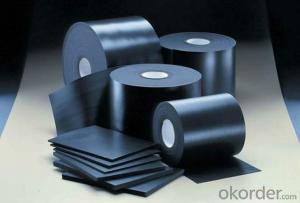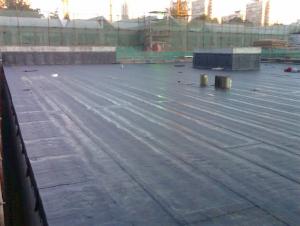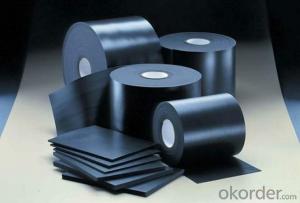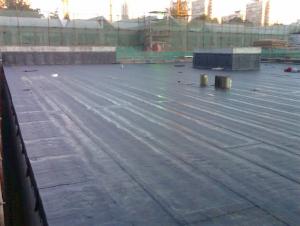EPDM Coiled Rubber Waterproof Membrane for Roof Project
- Loading Port:
- Shanghai
- Payment Terms:
- TT OR LC
- Min Order Qty:
- 20000 m²
- Supply Capability:
- 5000000 m²/month
OKorder Service Pledge
OKorder Financial Service
You Might Also Like
EPDM Coiled Rubber Waterproof Membrane for Roof Project
Description Of EPDM Coiled Rubber Waterproof Membrane for Roof Project:
This waterproof coiled material is of high elasticity with best performance among high polumer
waterproof coiled material in the world.It is also the most typical one in the world.Waterproof coiled material made of ternary ethylene-propylene rubber is produced withthe use of the most advanced contiuous extrusion and vulcanization technology and related equipments which are specially designed for production of such product.It is good in compactness,without bubble and performance difference in length and breadth,perfomances reach or exceedthe demands of GB18173.1-2000 standard.
Main Features of EPDM Coiled Rubber Waterproof Membrane for Roof Project:
A.Polyester based SBS Modified Bitumen Waterproofing Membrane
a. Strong impermeability
b. High tensile strength, elongation, ability to adapt the grassroots shrinkage deformation and cracking
c. Puncture-resistant, broken resistant, tear-resistant
d. The corrosion resistance, resistance to mildew, weathering good
e. Construction convenient, hot-melt can be operated Four Seasons Construction, reliable joints
B. Fiberglass based SBS Modified Bitumen Waterproofing Membrane
a. High tensile strength, stability of a good size
b. High Temperature good performance
c. Damage resistance, corrosion resistance, resistance to mildew, weathering good performance
d. Good construction performance, reliable joints.
Specifications of EPDM Coiled Rubber Waterproof Membrane for Roof Project:
| Material | EPDM Rubber |
| Size | 1.2m (width)*20m (length) or customized, weldable type 2.05m or 4m width |
| Thick | 1.2mm, 1.5mm, 2.0mm |
| Type | Vulcanized & Weldable |
| Pattern | Non-reinforced (homogeneous) |
| Certificate | ISO9001/14001 |
Applications of EPDM Coiled Rubber Waterproof Membrane for Roof Project:
1. Make sure the base surface smooth, clean and dry(Moisture<9%), then paint the delicated agent on the base surface. Start application till it is dry.
2. Reinforce the parts which are easy to leak, such as seam, hole, channel, wall, pipe and corner.
3. Application Method:Lay the membrane directly. Be careful to control the overlaps of the long side and short side.
4. After application, a careful inspection is required. Make sure there is no air bubble, no fold, no falling away etc to guarantee the waterproof life.
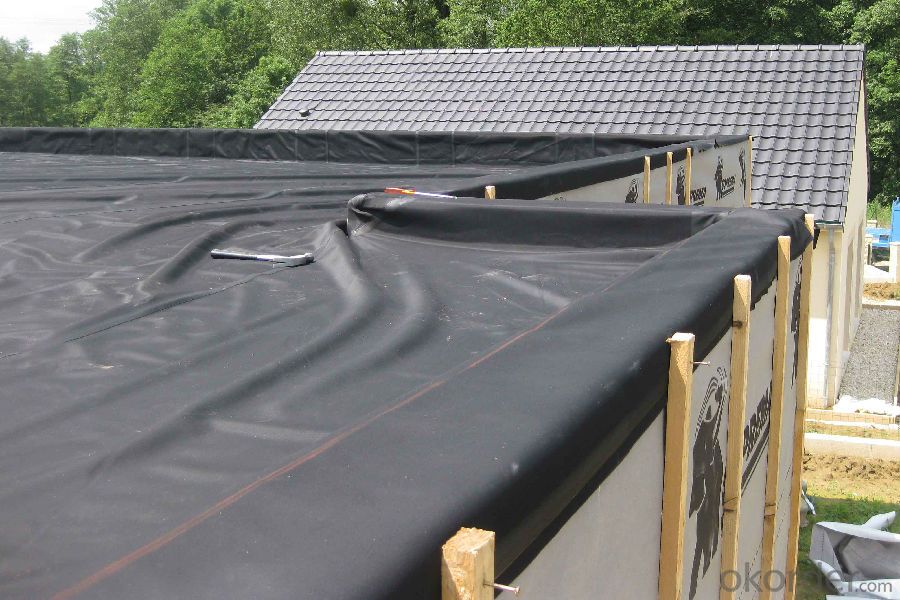


IMages of EPDM Coiled Rubber Waterproof Membrane for Roof Project:
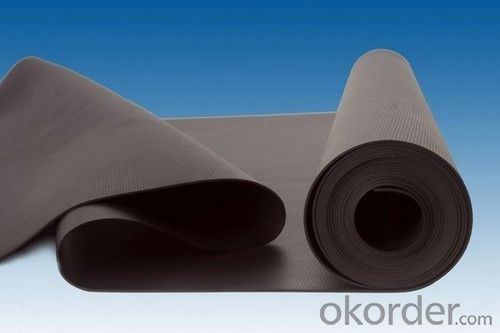



FAQ of EPDM Coiled Rubber Waterproof Membrane for Roof Project:
1. What are we supplying?
We are specialized in producing Colorful Asphalt Roof Shingle, SBS/APP modified bitumen waterproof membrane, Self adhesive bitumen waterproof membrane, PVC waterproofing membrane, EPDM rubber roofing membrane, Single Component Polyurethane Waterproof Coating, and Spray Polyurea Waterproof Coating
.
2. How Many years experience do we have?
We have been exported to more than 20 countries in the past 15 years.
3. How long do we usually reply your request?
We always reply our customer within 24 hours.
- Q: Can a waterproofing membrane be used on PVC roofs?
- PVC roofs, commonly found in commercial and residential buildings, are known for their durability and resistance to weathering. However, like all roofing materials, they can develop leaks and cracks over time. To combat this issue, a waterproofing membrane can be applied to PVC roofs. This membrane, such as EPDM or TPO, is flexible and can easily adhere to the PVC surface, forming a seamless and watertight barrier. It is crucial to ensure that the chosen waterproofing membrane is compatible with PVC roofs and to carefully follow the manufacturer's instructions for proper installation. Additionally, regular maintenance and inspections are highly recommended to promptly detect and address any potential problems before they worsen.
- Q: Are waterproofing membranes resistant to frost damage?
- Waterproofing membranes, in general, exhibit resistance towards frost damage. These membranes are specifically crafted to endure diverse weather conditions, which include freezing temperatures. They typically comprise modified bitumen, PVC, EPDM, or TPO, materials renowned for their exceptional frost and environmental resistance. These materials are engineered to maintain their flexibility and elasticity, even in low temperatures, ensuring the preservation of the waterproofing membrane's effectiveness in preventing water infiltration. Furthermore, meticulous installation methods and regular maintenance can augment the waterproofing membranes' resistance to frost damage.
- Q: Are waterproofing membranes resistant to seawater?
- Yes, waterproofing membranes are generally resistant to seawater. They are designed to provide a barrier against water infiltration, including salty seawater, and are commonly used in various marine applications.
- Q: Can a waterproofing membrane be applied on top of roofing materials?
- Applying a waterproofing membrane on top of roofing materials is a common practice in the construction industry. This is crucial for areas with heavy rainfall or extreme weather conditions, as it provides an extra layer of protection against water infiltration. The waterproofing membrane acts as a barrier, preventing water from seeping through the roof and causing damage to the underlying structure. It is worth noting that depending on the type of membrane used, it can also improve insulation and enhance the energy efficiency of the building. To ensure the effectiveness and longevity of the waterproofing system, it is important to follow proper installation techniques and adhere to the manufacturer's guidelines. It is advisable to consult with a professional roofing contractor or waterproofing specialist to determine the most suitable membrane and installation method for your specific roofing materials and conditions.
- Q: Can a waterproofing membrane be used on precast nickel surfaces?
- Yes, a waterproofing membrane can be used on precast nickel surfaces. Waterproofing membranes are designed to create a barrier against moisture and prevent water penetration. They can be applied to various surfaces, including concrete, metal, and even nickel. However, it is important to ensure that the waterproofing membrane is suitable for use on nickel surfaces and is compatible with the specific type of precast nickel being used. It is recommended to consult with a professional waterproofing contractor or the manufacturer of the membrane for guidance on the specific application and to ensure proper adhesion and effectiveness of the membrane on precast nickel surfaces.
- Q: Are there any specific considerations for installing a waterproofing membrane on masonry surfaces?
- Yes, there are several specific considerations to keep in mind when installing a waterproofing membrane on masonry surfaces. Firstly, it is important to thoroughly clean and prepare the masonry surface before installing the membrane. This includes removing any loose debris, dirt, or old coatings that could hinder the membrane's adhesion. Secondly, it is crucial to choose the right type of waterproofing membrane that is suitable for masonry surfaces. Masonry surfaces can vary in terms of porosity and texture, so selecting a membrane that is compatible with the specific type of masonry is important for achieving optimal results. Additionally, it is essential to ensure proper surface preparation and priming before applying the membrane. This may involve using a primer that helps improve adhesion and creates a strong bond between the masonry and the membrane. Moreover, the installation technique plays a crucial role in the effectiveness of the waterproofing membrane. Care should be taken to apply the membrane evenly and smoothly, avoiding any gaps, wrinkles, or air bubbles that might compromise its performance. It is also important to pay attention to the manufacturer's guidelines and recommendations regarding the application method and curing time. Lastly, regular inspection and maintenance are necessary to ensure that the waterproofing membrane remains in good condition over time. This may involve periodically checking for any signs of damage, such as cracks or peeling, and promptly addressing any issues that arise. By considering these specific factors, a waterproofing membrane can be effectively installed on masonry surfaces, providing long-lasting protection against water infiltration and damage.
- Q: Is a waterproofing membrane suitable for both residential and commercial applications?
- Indeed, both residential and commercial applications can benefit from the use of a waterproofing membrane. This versatile material can effectively safeguard buildings and structures against water damage in various environments. Whether it be a residential dwelling or a commercial edifice, foundations, roofs, walls, and other vulnerable areas can be fortified with a waterproofing membrane to prevent water infiltration. In doing so, it acts as a protective shield, averting issues like leaks, mold, and decay that may arise from water seepage. Moreover, the adaptability of a waterproofing membrane allows for customization to address the specific needs and prerequisites of both residential and commercial applications, thus rendering it an appropriate choice for any building type.
- Q: Can a waterproofing membrane be used on glass block surfaces?
- No, a waterproofing membrane cannot be used on glass block surfaces as they are already inherently waterproof.
- Q: Can a waterproofing membrane be used on stadium seating areas?
- Yes, a waterproofing membrane can be used on stadium seating areas to provide protection against water damage and ensure the longevity of the seating structure.
- Q: Can a waterproofing membrane be used for tunnels or underground structures?
- Yes, a waterproofing membrane can be used for tunnels or underground structures. Waterproofing membranes are specifically designed to prevent the ingress of water and protect structures from moisture damage. Tunnels and underground structures are often exposed to groundwater or high levels of moisture, making waterproofing essential to maintain their integrity and durability. The waterproofing membrane is applied to the exterior surface of the tunnel or underground structure, creating a barrier that prevents water penetration. It acts as a protective layer, preventing water from seeping through the walls, roof, or floor. There are various types of waterproofing membranes available, including bituminous, polyurethane, and cementitious membranes. Each type offers different properties and advantages depending on the specific requirements of the project. In addition to preventing water infiltration, waterproofing membranes also provide protection against other potential issues such as corrosion, mold growth, and structural damage. They help to extend the lifespan of the tunnel or underground structure and reduce maintenance and repair costs. It is important to ensure that the waterproofing membrane is properly installed by qualified professionals to ensure its effectiveness. Regular inspections and maintenance are also crucial to identify any potential issues and address them promptly. Overall, a waterproofing membrane is a highly effective solution for tunnels and underground structures, providing long-lasting protection against water damage and ensuring their structural integrity.
Send your message to us
EPDM Coiled Rubber Waterproof Membrane for Roof Project
- Loading Port:
- Shanghai
- Payment Terms:
- TT OR LC
- Min Order Qty:
- 20000 m²
- Supply Capability:
- 5000000 m²/month
OKorder Service Pledge
OKorder Financial Service
Similar products
Hot products
Hot Searches
Related keywords
